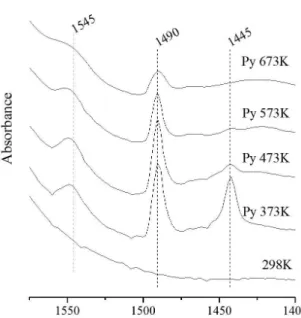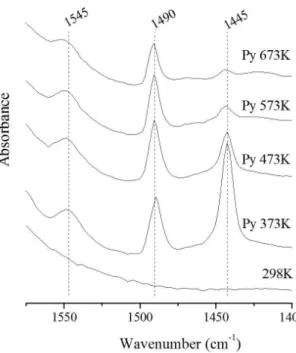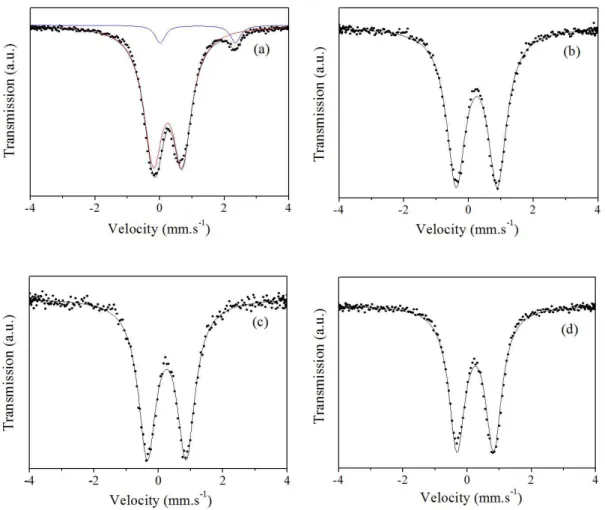*e-mail: lindomar@dqoi.ufc.br
Study of the Effects of Lanthanum and the Iron Ion on the
Acidic Properties of Al-pillared Vermiculite
Marcus Venicio da Silva Fernandes, Lindomar Roberto Damasceno da Silva*
Departamento de Química Orgânica e Inorgânica, Universidade Federal do Ceará – UFC, Fortaleza, CE, Brazil
Received: September 9, 2012; Revised: May 20, 2013
The synthesis of porous materials has attracted interest for decades due to their applications in catalysis and gas adsorption. Clay obtained by insertion of mesoporous oligomer [LaxAl13-xO4 (OH)24 (H2O)12]7 + (where x equals the molar amount of lanthanum), followed by calcination, may cause
variation in the acidic properties. The analyzes showed that increasing the amount of La on oligomer results in a higher acidity shown in the spectrum a characteristic band in the region of 1445 and 1545cm–1
to Lewis and Brönsted respectively, predominantly of the last one. The Mössbauer spectroscopy results showed a relationship between increased symmetry of the octahedral site of iron (Fe3+) and increased
lanthanum doping, and consequently a sharp increase in acidity.
Keywords: acidity, mesoporous clay, lanthanum
1. Introduction
The first reports about obtaining clays mesoporous metal oxide occurred at the beginning of the 1970s. Since then the issue has been addressed in many studies1-5. Ions
such as Keggin, also called an polycationic oligomer Al136,7,
which has the empirical formula [Al13O4(OH)24(H2O)12]7+,
are interspersed in the clay lamellae such as smectites and vermiculites by ion exchange8, which will subsequently
calcined to obtain crystalline oxides structures like pillars in the clays internal structures9,10.
Textural and catalytic properties of the mesoporous clays are related to its intrinsic characteristics due great exposure of active sites by the presence of metal oxides or pillars in the interlayer spacing, thereby increasing the surface area and creating porosity in the material. Acidity study in pillared clays is of great importance due may help in understanding the catalytic selectivity, depending on the acid sites distribution11,12.
Clay minerals from smectite group possess layered structure formed by tetrahedral and octahedral sheets. The tetrahedral contain mainly Si(IV) as the central atom, while the octahedral sites are occupied by Al(III), Fe(III) or Mg(II). Two types of octahedral sheets occur in clay minerals: the dioctahedral type, where two-thirds of the octahedral sites are occupied mainly by Al(III), Fe(III) or Mg(II) and the trioctahedral type, with most of the sites occupied by Mg(II) or Li(I)13-15. Iron is another important characteristic of the
clay, which is a chemical species naturally occurring clay minerals from the vermiculites group16,17.
Generally, the pillared clays properties depends on the modifying agent position. This behavior can be well evaluated by different methods, such as IR, Mössbauer spectroscopy, NMR, and others18. Related processes due iron
presence in the clay is best understood using the Mössbauer spectroscopy.
This work aims to obtain mesoporous material by intercalation aluminum oligomer ([OH–]/[Al3+] = 2.4) in
vermiculite previously modified, followed by pillaring by calcination at 773K, and acidity increasing studies by aluminum doping (Al13) in lanthanum (12Al : 1La and 11Al : 2La ) and iron possible effects related.
2. Material and Methods
Precursor clay samples (vermiculite) are from the Paraiba State, Brazil. All of them were dried at 373K, crushed and sieved to 200 mesh to obtain a material with homogeneous particle size. Vermiculite treated with HNO3 at 0.8 mol.L-1 353K, calcined at 873K for 2 hours, was
treated with oxalic acid 0.12 mol L–1 to 353K at reflux
exchangeable for iron removal, next, was added NaCl 3 mol.L–1 to obtain the sodium form (VNa) (Table 1).
Aluminum oligomer (Al13) was prepared by addition of NaOH 0.2 mol.L–1 in AlCl
3.6H2O 0.2 mol.L–1 at reflux.
Aluminum oligomer doped lanthanum (LaxAl13-x), were obtained from solutions of NaOH 0.2 mol.L–1, AlCl
3.6H2O
0.2 mol.L–1 and LaCl
3 .6 H2O 0.2 mol.L–1, seeing x equals
to 1 or 2. Oligomers were obtained by considering the ratio OH / (Al + La) = 2.4. Oligomer solution with stirring at 353K was added to the sample VNa dispersed in deionized water (10% m.V–1) under stirring for 24 hours, obtaining
the interleaved samples, which were washed with deionized water and dried at 373K, crushed and calcined at 773K for 3 hours.
(373K - 673K). Weight W (g) and diameter D (cm) of each sample were recorded for the measurement of the Brönsted and Lewis acid sites (qB,L) using an equation:
qB,L =(π.A.D2). (4.W.ε
B,L)–1 (1)
where A is the integrated area of the band (a) and ε
B, L, molar
extinction coefficient (µmol.g–1)19,20.
Mössbauer spectra were recorded in transmission mode at room temperature with a radioactive source 57Co rhodium
matrix mounted in a speed control operating mode sine ranging from –4 to +4 mm.s–1, to observe all transitions
possible energy hyperfine parameters of structural iron (57Fe) nuclei.
3. Results and Discussion
3.1.
Acidity characterization
Some authors, such as Pálkova et al.13 and Nunes et al.21
suggest that acidic properties of pillared clays are attributed to the presence of SiOH or AlOH groups. An efficient way to investigate this association is the use of organic bases such as pyridine, which second Chmielarz et al.22, has frequently
been used in the study of acidic sites.
According Akçay11 and Benvenutti et al.23, distinction
between the of Lewis and Bronsted acidity is based on the position of certain vibrational modes (Table 2) of pyridine molecule known as 8a and 19b. Pyridine is a strong base and a proton transfer, resulting in the formation of ions when the pyridinium molecules interact with Brönsted acid sites.
Figures 1, 2 and 3 show pyridine spectra adsorbed on samples of the oligomers modified with vermiculite Al13, LaAl12 and La2Al11 respectively, at different temperatures: 373K, 473K, 573K and 673K. Stretch region in the spectra of 1580-1550 cm–1 and 1455-1440 cm–1 band 19b are
characteristics to the Brönsted and Lewis sites (Table 2), respectively.
Table 1. Description of the samples.
Sample Description
VERM Natural vermiculite VNa Sodium vermiculite Al13PILV Al13-Pillared vermiculite LaAl12PILV LaAl12-Pillared vermiculite La2Al11PILV La2Al11-Pillared vermiculite
Table 2. Pyridine bands adsorbed on the solid surface according
Benvenutti et al.23 and Akçay11.
Modes Wave number (cm
–1)
FA LH CSL PSB
8a c.a. 1580 c.a. 1595 1600-1630 c.a. 1640
19b c.a. 1438 c.a. 1444 1447-1465 1530-1550
Figure 1. FT-IR spectra of pyridine adsorbed on the sample Al13PILV.
Figure 2. FT-IR spectra of pyridine adsorbed on the sample LaAl12PILV.
Gyftopoulou et al.24 report the samples acidic character
Figure 4. qB,L, (mmol.g–1) vs. Temperature (K) of measurement of the Brönsted acid sites (–□–) and Lewis (––) of the samples: (a) VAl13PIL, (b) VLaAl12PIL and (c) VLa2Al11PIL.
Figure 3. FT-IR spectra of pyridine adsorbed on the sample
La2Al11PILV.
Figures 1, 2 and 3, the band at 1445cm–1 on Lewis
sites increases significantly as the amount of lanthanum incorporated increases. Layman et al.25, Shimizu et al.26
and Yazıcı et al.27 noted that the region in 1490 cm–1
correspond Lewis and Brönsted acid sites, who also undergo changes in their intensities. However, these changes and thermal degradation of Lewis and Brönsted acid sites (Figure 4), are not as significant, and appear to be related to the fact that the lanthanum is not in a central position in the oligomer, and also the greater stability than Lewis sites acquire when they are located in this specie.
Figure 4 shows a significant increase in Lewis acidity, related to the higher percentage (% w/w) of lanthanum in the oligomer, which shows that the concentration of Lewis sites triples. Twice lanthanum the oligomer, the concentration of sites increases approximately eight times.
3.2.
Mössbauer spectroscopy
Parameter values hyperfine obtained by adjusting the Mössbauer spectra are shown in Table 3. All Mössbauer spectra (Figure 5a-d) obtained from samples in powder of natural and pillared clay with aluminum and aluminum - lanthanum, show the presence of Fe3+, and still
observing (Figure 5a) that only natural vermiculite (VERM) presented Fe2+.
Mössbauer spectra (Figure 5) may elucidate doubt as iron may affect the thermal stability of the obtained material and possibly iron and interacts only with pillared aluminum oligomer (Al13) and aluminum-doped lanthanum oligomers (LaAl12 and La2Al11).
Al13PILV, and LaAl12PILV La2Al11PILV showed quadrupole splitting values (∆) * significantly different
(1.28, 1.21 and 1.14 mm. s–1), respectively, as shown
in Table 3, decreasing values show an increase in the organization octahedral site iron could be related growing pillars doping with lanthanum and increased acidity.
According Carriazo et al.28 may be slight variations
in the parameters δ and ∆
EQ, especially considering the
chemical environment of Fe3+ in the mineral structure
may vary slightly, and distortion may occur in the geometry sites of Fe3+ due loss of water or OH groups in
Figure 5. Mössbauer spectra of (a) VERM, (b) Al13PILV, (c) LaAl12PILV and (d) La2Al11PILV.
Table 3. Hyperfine parameters vermiculite at different steps.
Sample Assignment δ (mm.s–1) ∆E
Q(mm.s
–1) Γ (mm.s–1)
VERM FeFe3+2+ 0.341.28 0.892.33 0.710.37
Al13PILV LaAl12PILV La2Al11PILV
Fe3+ Fe3+ Fe3+
0.37 0.38 0.37
1.28* 1.21* 1.14*
0.70 0.67 0.61
δ: isomer shift (measured relative to α-Fe); ∆E
Q: quadrupole splitting; Γ: line width.
4. Conclusions
Aluminum doped lanthanum oligomer (LaAl12PILV
and La2Al11PILV) showed Lewis and Brönsted sites
predominance at temperatures up to 373K and 573K respectively. The Brönsted sites showed greater thermal stability in all modified clay samples. Mössbauer spectra indicated a possible relationship between increased
octahedral site Fe3+ symmetry, lanthanum/aluminum doped
oligomer and higher acidity.
Acknowledgements
This work was financially supported by the CNPQ, CAPES and Policlay NT.
References
1. Huang Q, Zuo S and Zhou R. Catalytic performance of pillared interlayered clays (PILCs) supported CrCe catalysts for deep oxidation of nitrogen-containing VOCs. Applied Catalysis B:
Environmental. 2010; 95:327-334. http://dx.doi.org/10.1016/j. apcatb.2010.01.011
Clays and Clay Minerals. 2006; 54(6):737-747. http://dx.doi.
org/10.1346/CCMN.2006.0540608
3. Gil A, Trujillano R,Vicente MA and Korili SA. Hydrogen adsorption by microporous materials based on alumina-pillared clays. International Journal of Hydrogen Energy. 2009; 34:8611-8615. http://dx.doi.org/10.1016/j.
ijhydene.2009.08.057
4. Gil A, Korili SA, Trujillano R and Vicente MA. A review on characterization of pillared clays by specific techniques.
Applied Clay Science. 2011; 53:97-105. http://dx.doi.
org/10.1016/j.clay.2010.09.018
5. Yuan P, Annabi-Bergaya F, Taoa Q, Fan M, Liu Z, Zhu J et al. A combined study by XRD, FTIR, TG and HRTEM on the structure of delaminated Fe-intercalated/pillared clay.
Journal of Colloid and Interface Science. 2008; 324:142-149.
PMid:18502444. http://dx.doi.org/10.1016/j.jcis.2008.04.076 6. Jiménez de Haro MC, Rodríguez JL, Poyato J, Pérez-Maqueda LA, Ramírez-Valle V, Justo A et al. Effect of ultrasound on preparation of porous materials from vermiculite.
Applied Clay Science. 2005; 30(1):11-20. http://dx.doi.
org/10.1016/j.clay.2005.02.004
7. Kloprogge JT, Duong LV. and Frost RL. A review of the synthesis and characterisation of pillared clays and related porous materials for cracking of vegetable oils to produce biofuels. Environmental Geology. 2005. http://dx.doi.
org/10.1007/s00254-005-1226-1
8. Altunlu M and Yapar S. Effect of OH-–/Al3+ and Al3+/clay ratios on the adsorption properties of Al-pillared bentonites.
Colloids and Surfaces A: Physicochemical and Engineering
Aspects. 2007; 306:88-94. http://dx.doi.org/10.1016/j. colsurfa.2006.10.071
9. Chmielarz L, Kus’trowski P, Piwowarska Z, Dudek B, Gil B and Michalik M. Montmorillonite, vermiculite and saponite based porous clay heterostructures modified with transition metals as catalysts for the DeNOx process. Applied Catalysis B:
Environmental. 2009; 88:331-340. http://dx.doi.org/10.1016/j. apcatb.2008.11.001
10. Zhu L, Tian S, Zhu J and Shi Y. Silylated pillared clay (SPILC):A novel bentonite-based inorgano-organo composite sorbent synthesized by integration of pillaring and silylation.
Journal of Colloid and Interface Science. 2007; 315:191-199. PMid:17659295. http://dx.doi.org/10.1016/j.jcis.2007.06.053 11. Akçay, M. FT-IR spectroscopic investigation of the adsorption
pyridine on the raw sepiolite and Fe-pillared sepiolite from Anatolia. Journal of Molecular Structure. 2004; 694:21-26. http://dx.doi.org/10.1016/j.molstruc.2004.01.010
12. Hernández WY, Centeno MA, Odriozola JA, Moreno S and Molina R. Acidity characterization of a titanium and sulfate modified vermiculite. Materials Research Bulletin. 2008; 43:1630-1640. http://dx.doi.org/10.1016/j. materresbull.2007.10.018
13. Pálková H, Madejová J, Zimowska M and Serwicka EM. Laponite-derived porous clay heterostructures: II. FTIR study of the structure evolution. Microporous and Mesoporous Materials. 2010; 127:237-244. http://dx.doi.org/10.1016/j. micromeso.2009.07.012
14. Brigatti MF, Galan E and Theng BKG. Structures and mineralogy of clay minerals. In: Handbook of Clay Science. 2006. v. 1, capt. 2, p. 19-69.
15. Maqueda C, Perez-Rodriguez JL, Šubrt J and Murafa N. Study of ground and unground leached vermiculite. Applied Clay Science. 2009; 44:178-184. http://dx.doi.org/10.1016/j.
clay.2009.01.019
16. Marcos C and Rodriguez I. Expansion behaviour of commercial vermiculites at 1000 °C. Applied Clay Science. 2010; 48:492-498.
http://dx.doi.org/10.1016/j.clay.2010.02.012
17. Zhang K, Xu J, Wang KY, Cheng L, Wang J and Liu B. Preparation and characterization of chitosan nanocomposites with vermiculite of different modification. Polymer Degradation and Stability. 2009; 94:2121-2127. http://dx.doi.org/10.1016/j. polymdegradstab.2009.10.002
18. Pálinkó I, Lázár K and Kiricsi I. Cationic mixed pillared layer clays: infrared and Miissbauercharacteristics of the pillaring agents and pillared structures in Fe,Al and Cr,Al pillared montmorillonites.
Journal of Molecular Structure. 1997; 410-411:547-550. http://
dx.doi.org/10.1016/S0022-2860(96)09516-6
19. Del Rey-Perez-Caballero FJ and Poncelet G. Microporous 18Å Al-pillared vermiculites: preparation and characterization.
Microporous and Mesoporous Materials. 2000; 37:313-327. http://dx.doi.org/10.1016/S1387-1811(99)00274-7
20. Del Rey-Perez-Caballero FJ and Poncelet G. Preparation and characterization of microporous 18Å Al-pillared structures from natural phlogopite micas. Microporous and Mesoporous Materials. 2000; 41:169-181.
http://dx.doi.org/10.1016/S1387-1811(00)00284-5
21. Nunes CD, Pires J, Carvalho AP, Calhorda MJ and Ferreira P. Synthesis and characterisation of organo-silica hydrophobic clay heterostructures for volatile organic compounds removal.
Microporous and Mesoporous Materials. 2008; 111:612-619. http://dx.doi.org/10.1016/j.micromeso.2007.09.008
22. Chmielarz L, Kustrowski P, Drozdek M, Dziembaj R, Cool P and Vansant EF. Selective catalytic oxidation of ammonia into nitrogen over PCH modified with copper and iron species. Catalysis Today. 2006; 114:319-325. http://dx.doi.
org/10.1016/j.cattod.2006.01.020
23. Benvenutti EV, Gushikem Y and Davanzo CU. Pyridine Used as a Probe for Internal Brönsted Acid Sites in Pyrochlore Antimony (V) Oxide: An Infrared Spectroscopy Study.
Applied Spectroscopy. 1992 46(10):1474-1476. http://dx.doi. org/10.1366/000370292789619179
24. Gyftopoulou ME, Millan M, Bridgwater AV, Dugwell D, Kandiyoti R and Hriljac JA. Pillared clays as catalysts for hydrocracking of heavy liquid fuels. Applied Catalysis A:General. 2005; 282:205-214. http://dx.doi.org/10.1016/j.
apcata.2004.12.012
25. Layman KA, Ivey MM and Hemminger JC. Pyridine Adsorption and Acid/Base Complex Formation on Ultrathin Films of ç-Al2O3 on NiAl(100). Journal of Physical Chemistry B. 2003; 107:8538-8546. http://dx.doi.org/10.1021/jp030046p 26. Shimizu K-I, Higuchi T, Takasugi E, Hatamachi T, Kodama
T and Satsuma A. Characterization of Lewis acidity of cation-exchanged montmorillonite K-10 clay as effective heterogeneous catalyst for acetylation of alcohol. Journal of Molecular Catalysis A: Chemical. 2008; 284:89-96. http://
dx.doi.org/10.1016/j.molcata.2008.01.013
27. Yazıcı DT and Bilgic C. Determining the surface acidic properties of solid catalysts by amine titration using Hammett indicators and FTIR-pyridine adsorptionmethods. Surface and Interface Analysis. 2010; 42:959-962. http://dx.doi.
org/10.1002/sia.3474
28. Carriazo JG, Centeno MA, Odriozola JA, Moreno S and Molina R. Effect of Fe and Ce on Al-pillared bentonite and their performance in catalytic oxidation reactions. Applied Catalysis A: General. 2007; 317:120-128. http://dx.doi.org/10.1016/j.


